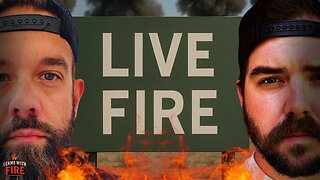Premium Only Content

Dog Walk at the Comanche Lookout Park #trending #comedy #highlights #dog #australia #history #hiking
The Comanche language is a Numic language of the Uto-Aztecan family. Originally, it was a Shoshoni dialect, but diverged and became a separate language.[4] The Comanche were once part of the Shoshone people of the Great Basin.[5]
In the 18th and 19th centuries, Comanche lived in most of present-day northwestern Texas and adjacent areas in eastern New Mexico, southeastern Colorado, southwestern Kansas, western Oklahoma, and northern Chihuahua. Spanish colonists and later Mexicans called their historical territory Comancheria.
During the 18th and 19th centuries, Comanche participated in nomadic horse culture and hunted, particularly bison. They traded with neighboring Native American peoples, and Spanish, French, and American colonists and settlers.
As European Americans encroached on their territory, the Comanche waged war on and raided their settlements, as well as those of neighboring Native American tribes.[6] They took captives from other tribes during warfare, using them as slaves, selling them to the Spanish and (later) Mexican settlers, or adopting them into their tribe.[5] Thousands of captives from raids on Spanish, Mexican, and American settlers, assimilated into Comanche society.[7]
Decimated by European diseases, warfare, and encroachment by Europeans on Comancheria, most Comanche were forced to live on reservations in Indian Territory by the 1860s and 1870s.[5]
In the 21st century, the Comanche Nation has 17,000 members, around 7,000 of whom reside in tribal jurisdictional areas around Lawton, Fort Sill, and the surrounding areas of southwestern Oklahoma.[2] The Comanche Homecoming Annual Dance takes place in mid-July in Walters, Oklahoma.[8]
The Proto-Comanche movement to the Plains was part of the larger phenomenon known as the “Shoshonean Expansion” in which that language family spread across the Great Basin and across the mountains into Wyoming. The Kotsoteka (‘Bison Eaters’) were probably among the first. Other groups followed. Contact with the Shoshones of Wyoming was maintained until the 1830s when it was broken by the advancing Cheyennes and Arapahoes.
After the Pueblo Revolt of 1680, various Plains peoples acquired horses, but it was probably some time before they were very numerous. As late as 1725, Comanches were described as using large dogs rather than horses to carry their bison hide "campaign tents".[16]
The horse became a key element in the emergence of a distinctive Comanche culture. It was of such strategic importance that some scholars suggested that the Comanche broke away from the Shoshone and moved south to search for additional sources of horses among the settlers of New Spain to the south (rather than search for new herds of buffalo.) The Comanche have the longest documented existence as horse-mounted Plains peoples; they had horses when the Cheyennes still lived in earth lodges.[17]
The Comanche supplied horses and mules to all comers. As early as 1795, Comanche were selling horses to Anglo-American traders [18] and by the mid-19th century, Comanche-supplied horses were flowing into St. Louis via other Indian middlemen (Seminole, Osage, Shawnee).[19]
Their original migration took them to the southern Great Plains, into a sweep of territory extending from the Arkansas River to central Texas. The earliest references to them in the Spanish records date from 1706, when reports reached Santa Fe that Utes and Comanches were about to attack.[18] In the Comanche advance, the Apaches were driven off the Plains. By the end of the 18th century the struggle between Comanches and Apaches had assumed legendary proportions: in 1784, in recounting the history of the southern Plains, Texas governor Domingo Cabello y Robles recorded that some 60 years earlier (i.e., ca. 1724) the Apaches had been routed from the southern Plains in a nine-day battle at La Gran Sierra del Fierro ‘The Great Mountain of Iron’, somewhere northwest of Texas. There is, however, no other record, documentary or legendary, of such a fight.[16]
They were formidable opponents who developed strategies for using traditional weapons for fighting on horseback. Warfare was a major part of Comanche life. Comanche raids into Mexico traditionally took place during the full moon, when the Comanche could see to ride at night. This led to the term "Comanche Moon", during which the Comanche raided for horses, captives, and weapons.[20] The majority of Comanche raids into Mexico were in the state of Chihuahua and neighboring northern states.[21]
#2 #8 #texashillcountry #hillcountry #marblefallstx #longhorncaverns #texasstateparks #stateparks #adventureinthehillcountry #caves
#undergroundcave #exploretexas #views #weekendintexas #weekendgetaway #explore #traveltexas #doingthings #weddingceremony #austincaves
#pictureoftheday #photography #roadtrip #visualsoflife #agameoftonestexas #longhorncavernsmy #timeflies #throwback #chosenfamily #austin
-
 6:29:40
6:29:40
SpartakusLIVE
15 hours ago#1 Massive MEAT-HEAD can't stop WINNING, can't stop FLEXING
92.8K -
 5:09:25
5:09:25
Drew Hernandez
15 hours agoGIDEON AI THREAT DETECTION SOFTWARE PUSH & NEW EPSTEIN EMAIL LEAK?
61.2K27 -
 2:03:51
2:03:51
TimcastIRL
11 hours agoTrans Minneapolis Shooter BLAMED Massacre On Mom & Gender Transition | Timcast IRL
206K383 -
 47:29
47:29
Man in America
18 hours agoIT DOESN'T ADD UP: The Trans Shooter's Story Is FULL of Holes
71.5K85 -
 3:59:36
3:59:36
StevieTLIVE
11 hours agoFriday Night Warzone HYPE
50.5K1 -
 3:47:10
3:47:10
SynthTrax & DJ Cheezus Livestreams
1 day agoFriday Night Synthwave 80s 90s Electronica and more DJ MIX Livestream Michael Jackson / AI Art Compilation Edition
57.3K2 -
 1:03:57
1:03:57
Sarah Westall
11 hours agoMara Lago Accord Joins the Fed, Fed Waves the White Flag & more w/ Andy Schectman
38.2K2 -
 2:44:12
2:44:12
I_Came_With_Fire_Podcast
1 day ago*BREAKING* Special Guest Katarina Szulc
47.3K9 -
 3:22:20
3:22:20
megimu32
11 hours agoOFF THE SUBJECT: FAFO Friday! Bodycams & Mario Kart Mayhem!
31.3K5 -
 55:36
55:36
Flyover Conservatives
1 day ago4 Strategies to Create Opportunity from Nothing - Clay Clark | FOC Show
34.6K1